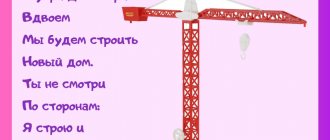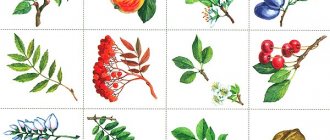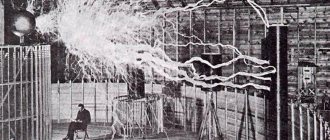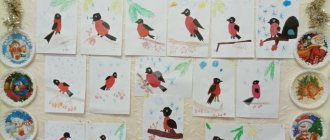Summary of educational activities for cognitive development with children of the preparatory group “Types of transport”
GCD in the preparatory group of a preschool educational institution.
Preparatory group Program objectives: 1. Develop knowledge about transport, its types 2. Develop children’s ability to distinguish between land, air and water transport.
3. Develop mental activity and attention. 5. Cultivate cognitive interest Progress:
Organizational moment. Guys, before we start our lesson, I want to invite you to solve riddles . 1. This horse does not eat oats, instead of legs there are two wheels. Sit on horseback and race on it, but it’s better to steer. (Bicycle) 2. A wonderful long house, There are many passengers in it. Wears shoes made of rubber And eats gasoline... (Bus) 3. Doesn't fly, but buzzes, A beetle runs down the street. And two brilliant lights burn in the beetle’s eyes. (Car) 4. Amazing carriage! Judge for yourself: The rails are in the air, and he holds them with his hands. (Trolleybus) 5. Well, my friend, guess, Only this is not a tram. A line of huts quickly rushes into the distance along the rails. (Train) 6. The giant lifts a lot of cargo to the clouds. Where he stands, then a new house grows. (Crane) 7. Without accelerating, it takes off high, Reminds me of a dragonfly, Sets off on a high-speed flight... (Helicopter) 8. Here is a steel bird, It strives for the skies, And its pilot leads it. What kind of bird? (Airplane) Well done, you guessed all the riddles. Now call it all in one word / Transport
Correctly, the topic of our lesson today is “Transport”
Conversation “Types of Transport” Transport can be different not only in appearance, but also in purpose, and also in the place of movement. What kind of transport do you think is called air transport? / Children's answers
Air transport is transport that moves through the air.
Name air transport / Plane, helicopter, parachute, airship, airplane, hot air balloon.
Air transport is the fastest mode of transport.
Air transport is mainly used for passenger transportation over distances of over a thousand kilometers. Freight transport is also carried out, but their share is very low. Most often, perishable products and especially valuable cargo, as well as mail, are transported by air. What kind of transport is called water transport? / Children's answers
Water transport is transport that moves on water. Name water transport. / Submarine, ship, kayak, boat, raft
Water transport is distinguished by its ability to transport very large loads.
Water transport is vital where land transportation is impossible: between continents, islands, and in poorly developed areas. The speed of water transport is relatively low, so at present it is almost never used for passenger transport. What kind of transport is called ground transport? / Children's answers
Ground transport is transport that moves on the ground. Name ground transport / Children's answers Ground transport is divided into different types of transport: trackless, road, railway
This is the most common type of transport. They use ground transport for various needs. For example, a passenger car for traveling short distances. Trains, trams, trolleybuses, electric trains are needed to transport passengers and are called public transport. Various dump trucks, trucks and Kamaz trucks are called freight transport, as they are used to transport goods. Motorcycles and bicycles are called two-wheelers and are used to travel around the area. There is also special transport, it is used by people of different professions. Such vehicles include an ambulance, a police car, a tractor, a fire truck, a garbage truck, a combine harvester, etc.
We got acquainted with different types of transport.
Now let’s see how well you can distinguish between air, water, and land transport. Didactic game "Fourth odd"
Great! Well done! Now I want to give you some homework. The teacher distributes road signs to the children.
For your next lesson, be prepared to talk about these road signs. The topic of our next lesson is “Road Safety”.
We recommend watching:
Summary of educational activities for cognitive development in the preparatory group "Journey to the North" Summary of educational activities in the preparatory group on the topic "Reservoirs" Summary of educational activities for cognition in the middle group on the topic "Transport" Summary of educational activities for speech development in the senior group on the topic: Transport
Similar articles:
Summary of a lesson in the preparatory group on the topic: Rules of conduct in kindergarten
Life safety lesson “Rules of safe behavior on water.” Preparatory group
Abstract of GCD in mathematics in the preparatory group. Counting to 11 and 12
Summary of mathematics lessons in the preparatory group. Number composition
Summary of mathematics lessons in the preparatory group. Adding and subtracting numbers
Topic: Transport
Goal: to generalize and systematize the idea of transport, to activate the vocabulary on this topic, the practical use of prefixed verbs and compiling a short descriptive story using questions.
Program content:
Developmental task: Teach children to generalize, classify vehicles: cargo, passenger, fine motor skills, coordination of speech with movement, visual attention and perception.
Educational speech tasks: compose a descriptive story about this transport toy using questions:
- practice the practical use of words with affectionate and magnifying connotations;
- practical use of prefixed verbs;
- agree nouns with adjectives in number, gender, case;
- learn to compose a whole from parts (cut pictures).
Corrective task: to train children in the use of feminine and masculine nouns; expand your vocabulary on the topic “transport”.
Educational task: to teach children through game images the rules of behavior in public transport.
Materials: toys transport, pictures of transport, cut-out pictures of transport, audio recording “Bus”, panorama of the city with images of transport.
Progress of the lesson
— Guys, how did you get to kindergarten today, who lives far away, what? (On foot, car, bus)
- Those who live next to the kindergarten came on foot, those who live far from the kindergarten - went by bus, car, taxi (the teacher places the corresponding pictures on the magnetic board). What is a car, a bus, a taxi? (Transport)
— What are the people who travel in passenger transport called? (Passengers)
— What is the name of the machine that helps transport cargo? (Cargo)
— What kind of cargo can trucks transport (Furniture, sand, snow, food, gasoline, milk, etc.)
Pay attention to the panorama of the city, consider the image of transport. Finger game “Let’s count.”
We will bend our fingers - (clench and unclench our fingers) We will name transport: Car, taxi, Tram, metro, bus (unclench our fingers, starting with the little finger) We clenched 5 fingers into a fist, named 5 types of transport. (clench your fingers into a fist, starting with the thumb).
— Who drives passenger and cargo transport (driver, driver).
Generalization from the teacher: Cars are our helpers, but without a driver they cannot work. The driver must know well the structure of his car and its parts.
- Do you know what main parts it consists of?
— What is the name of that part of the car where the driver sits and controls the car? (Cabin)
—Where do they put the cargo? (Body)
— Where do the passengers sit? (Salon)
— Without which part will the car never move? (Without wheel)
Game exercise “Riding on the bus”
“Now let’s all take a ride on the bus together.” Who will we be on the bus? (Passengers). How should passengers behave on the bus and why?
I will speak, and you answer:
— The bus from the stop ( departed ), to another stop ( arrived ). Then he climbed a small hill ( drove in or drove over ) and together with us he bridged ( moved over ). He quickly entered the tunnel ( drove ) and from there soon to a gas station ( went, arrived ).
Speech game “At a gas station”
All the cars in order arrive at the gas station. (with both hands “turn the steering wheel” in front of you) A fuel truck, a garbage truck, a milk truck with milk, a grain truck with fresh bread, and a heavy timber truck.
(Fingers alternately, starting with the little finger, touch the palm).
Having refueled, the bus went to the exhibition-salon ( arrived, stopped ).
— An exhibition-salon of vehicles “Funny Motors” opened in our group. I will be the director, and you will be the car sales managers. You must tell us about the transport you like and advertise it:
Car name.
What is she like: describe her appearance, color.
Name the parts.
What is it intended for?
— I’ll start with advertising: This is a bus. He is red. It has a cabin, wheels, many windows, doors. The bus carries passengers.
Listen to 3-4 stories.
- Guys, in the distant fairy-tale country of “Liliput” there live little people and everything they have is small: clothes, shoes, and transport.
Game exercise “Big-small”
| Educator | Children |
| car | machine |
| automobile | car |
| truck | truck |
| tram | tram |
| trolleybus | trolleybus |
| bus | bus |
Cars are our faithful and reliable assistants. But in order for them to serve for a long time, they need to be looked after, repaired, and placed in the garage.
Didactic game “Fix the car”
The drivers pressed hard on the pedals, the car fell apart into parts. Help, help, assemble a car from parts.
Children assemble cars piece by piece (from cut-out pictures). At the end they say what they did.
And now I’m turning you into a machine, whoever wants what kind. And each of you will leave the lesson with your own signal. Verbal game “Pretend to honk your car’s horn” (honk your horn loudly for goodbye, honk quietly for the cars to drive far away).
Notes on the lexical topic “Transport” for children 4-5 years old with severe speech impairments
A series of notes on the lexical topic "Transport" for children 4-5 years old with severe speech impairments
Description of work: this work contains 3 notes on direct educational activities on the lexical topic "Transport" for children 4-5 years old with severe speech impairments . The material is built on the principle of “from simple to complex” and corresponds to the objectives of “Speech therapy work to overcome ODD in children.” Didactic games and exercises offered in the notes contribute to the development of:
- phonemic awareness; — mental processes; - vocabulary and grammatical structure of speech; - connected speech.
Summary of lesson No. 1 on the topic “Transport”
Goal: to expand children’s understanding of transport. Objectives: 1. Continue teaching children to form nouns with diminutive suffixes. 2. Develop children’s ability to name a group of homogeneous objects with a generalizing word. 3. Strengthen children’s ability to answer questions in complete sentences. 4. Develop attention, memory, thinking, fine motor skills. Equipment: demonstration material: plot picture “Transport”; subject pictures depicting a car, truck, bus, plane, ship, train; pictures for the game “Big-Small”. handout: handout for the game “Trace the Truck and Color It.” Progress of the lesson I.Org.moment. 1.D/i “Choose an action.” II.Work on the topic of the lesson. 1. Conversation on the topic. The speech therapist shows the children the plot picture “Transport”. -Guys, look carefully at the picture and tell me what kind of transport you see in it? 2.D/i “Name the transport.” The speech therapist puts object pictures depicting transport on a typesetting canvas, and the children name them. 3.D/i “Name it in one word.” — Tell me, guys, what is transport needed for? (To transport people, goods.) - What can you call people who travel in transport? (Passengers.) 4.D/i “Parts of the machine.” The teacher shows the children a picture of a car and asks the children what parts it has. (The car has a cabin, body, wheels.) III. Physical education minute. “Truck” The truck is carrying sand. They walk in a circle, pretending to turn the steering wheel. The people are surprised: They stop, turn their faces in a circle, spread their arms, and make surprised faces. “This is such a miracle, miracles, There is sand in it under the sky.” Tilt your head right and left twice. They stretch on their toes, raising their arms up. IV.Continuation of work on the topic of the lesson. 1.D/i “Big-small”. 2.Work with the handout “Trace the truck by dots and color it.” V. Result.
Summary of lesson No. 2 on the topic “Transport”
Goal: to continue to expand children’s understanding of transport. Objectives: 1. Continue teaching children to write a short descriptive story using support cards. 2. Exercise children in understanding and using the prepositions “To”, “PO”, “FROM”, “ABOUT”, “ON”, “B”. 3. Strengthen children’s ability to guess an object based on essential features. 4.Develop attention, memory, thinking, fine motor skills. Equipment: demonstration material: subject pictures depicting transport; picture with the image of Dunno; pictures for the game “Where? Where? Where?"; support cards; pictures for the game "4 extra". Progress of the lesson I.Org.moment. D/i “Flies or doesn’t fly”: ship, bee, plane, sofa, rocket, truck, helicopter, car, bus, bullfinch. II.Work on the topic of the lesson. 1. D/i “Guess by the description.” The teacher tells the children that Dunno has come to visit and wants to play with them. — It's a big blue car. It has two wings and a tail. He's flying across the sky. (Airplane.) - This machine is needed to transport cargo. It has a cab, a body and wheels. (Truck.) - This vehicle is large and it has sails. It floats on water and transports people and cargo. (Ship.) - This transport travels on rails. He has a lot of carriages. He puffs: “Chuh-chukh-chukh.” (Train.) - We always use this transport to go to kindergarten and to work. (Bus, car.) 2. D/i “Name the transport.” 3. D/i “Name it in one word.” 4. Understanding and use of the prepositions “K”, “PO”, “FROM”, “ABOUT”, “ON”, “B”. D/i “Where? Where? Where?" The teacher shows the children pictures and asks questions: - Where does the bus (truck, train) go? (The bus is traveling on the road. The train is traveling on the rails. Etc.) - Where did the bus (truck, train) arrive? (The bus pulled up to the stop. The truck pulled up to the garage. The train pulled up to the station. Etc.) - Where did the bus stop? — Where did the bus (truck, train) leave from? (The bus pulled away from the stop. The truck pulled away from the garage. The train pulled out of the station.) - Where is the ship sailing? (The ship is sailing on the sea.) - Where did the ship sail to? (The ship sailed to the shore.) - Where did the ship sail from? (The ship sailed from the shore.) - Where is the plane flying? (The plane flies in the sky.) - Where did the plane take off from? (The plane took off from the ground.) - Where did the plane land? (The plane landed on the ground.) III. Physical education minute. IV.Continuation of work on the topic of the lesson. 1. Compilation of a short descriptive story on the topic. The teacher shows the children support cards and gives a sample story: - This is a truck.
A truck is a transport. Its body is red and its cabin is green. He is big. He transports goods. Then 2-3 children make up a story about their favorite transport using an analogy.
2.D/i “4 extra”. V. Result.
Summary of lesson No. 3 on the topic “Transport”
Goal: to consolidate children’s knowledge about transport. Objectives: 1. Continue to teach children to understand the content of the story and answer questions about the text. 2.Develop children’s ability to solve riddles. 3. Clarify, activate and develop vocabulary on the topic. 4.Develop attention, memory, thinking, fine motor skills. Equipment: demonstration material: picture of Dunno; subject pictures depicting transport; pictures from the story “Special machines”. handout: copybook. Progress of the lesson I.Org.moment. D/i “The one who tells me the transport will sit.” II.Work on the topic of the lesson. 1. Riddles of Dunno. The brothers got ready for a visit, clung to each other and rushed off on a long journey, only leaving a smoke behind. (Train.) It doesn’t flap its wings, but flies, Not a bird, but overtakes everyone. (Airplane.) A steam locomotive without wheels, That's a miracle locomotive. Has he gone crazy - walked straight across the sea? (Ship.) It doesn’t fly, it doesn’t buzz, the beetle is running down the street. And they burn in the beetle’s eyes - Two brilliant lights. (Car.) 2.D/i “Name the transport.” 3.D/i “Name it in one word.” 4. A speech therapist’s story about special-purpose machines. The speech therapist tells children about special-purpose machines, showing corresponding pictures. -One day, dad and Masha were walking down the street. Suddenly they heard the sound of a siren, and soon a car with a red cross appeared. All the cars immediately gave way to the loud car. “Dad, why is everyone letting this car through?” asked Masha. - Because it is a special machine. Such machines help a person in his work. There are snowplows, sprinklers, police cars. Sometimes, saving someone's life may require immediate help. Then a special ambulance is called. It has modern medical equipment. Doctors provide first aid to a person and, if necessary, can quickly take a seriously ill patient to the hospital. There are also fire trucks. They rush to respond to fire calls. A brigade of firefighters rescues people and, using special equipment, extinguishes the fire with foam and water. Special machines are always in a hurry to help someone. That's why everyone lets them through, Masha! III. Physical education minute. IV.Continuation of work on the topic of the lesson. 1. Conversation on the story “Special Purpose Vehicles.” — What cars did Papa tell Masha about? Tell me guys, what is an ambulance/fire truck for? What other special machines do you know? Why do people need special cars? 2. Working with copybooks. V. Result.
We recommend watching:
Summary of a lesson on speech development in the middle group on the topic: “Ukraine is my native land” Experience of a speech therapist teacher in a preschool educational institution Automation of whistling and hissing sounds in children in pictures The work of a speech therapist with parents in a preschool educational institution in accordance with the Federal State Educational Standard. Correction of speech disorders
Similar articles:
Summary of a lesson on speech development in the middle group on the topic “Our Street”
Traveling by various modes of transport
Contained in sections:
- Transport. Class notes 2007
Showing publications 1-10 of 165. All sections | Types of transport. Class notes
New
Photo
The best
Lesson summary on the topic “Modes of Transport” in the junior group
Summary of the lesson on the topic “ Types of transport ”
in the younger group.
Program content: Educational: - continue to form children’s ideas about geometric shapes (square, rectangle, circle, color (yellow, red, black)
; - develop the ability to distinguish and name...
Lesson summary for FCCM “Introduction to modes of transport” FCCM Topic: “Introduction to modes of transport ”
Goal: To expand children’s knowledge about land, water and air modes
of transport , places of movement of transport - land , water, air, the purpose of transport . Activate the dictionary on this topic. Materials: Images of transport ,…




